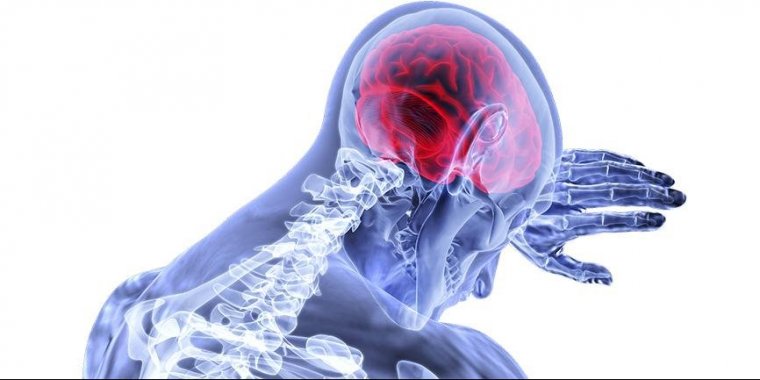| News / Science News |
Age and pre-existing conditions increase risk of stroke among COVID-19 patients
Fourteen out of every 1,000 COVID-19 patients admitted to hospital experience a stroke, a rate that is even higher in older patients and those with severe infection and pre-existing vascular conditions, according to a report published this week.

Brain inflammation stroke. Photo: VSRao
COVID-19 has become a global pandemic, affecting millions of people worldwide. In many cases, the symptoms include fever, persistent dry cough and breathing difficulties, and can lead to low blood oxygen.
However, the infection can cause disease in other organs, including the brain, and in more severe cases can lead to stroke and brain haemorrhage.
A team of researchers at the Stroke Research Group, University of Cambridge, carried out a systematic review and meta-analysis of published research into the link between COVID-19 and stroke.
This approach allows researchers to bring together existing – and often contradictory or under-powered – studies to provide more robust conclusions.
In total, the researchers analysed 61 studies, covering more than 100,000 patients admitted to hospital with COVID-19.
The researchers found that stroke occurred in 14 out of every 1,000 cases. The most common manifestation was acute ischemic stroke, which occurred in just over 12 out of every 1,000 cases.
Brain haemorrhage was less common, occurring in 1.6 out of every 1,000 cases. Most patients had been admitted with COVID-19 symptoms, with stroke occurring a few days later.
Age was a risk factor, with COVID-19 patients who developed stroke being on average (median) 4.8 years older than those who did not. COVID-19 patients who experienced a stroke were on average (median) six years younger than non-COVID-19 stroke patients. There was no sex difference and no significant difference in rates of smokers versus non-smokers.
Pre-existing conditions also increased the risk of stroke. Patients with high blood pressure were more likely to experience stroke than patients with normal blood pressure, while both diabetes and coronary artery disease also increased risk.
Patients who had a more severe infection with SARSCoV2 – the coronavirus that causes COVID-19 – were also more likely to have a stroke.
The researchers found that COVID-19-associated strokes often followed a characteristic pattern, with stroke caused by blockage of a large cerebral artery, and brain imaging showing strokes in more than one cerebral arterial territory.
They argue that this pattern suggests cerebral thrombosis and/or thromboembolism are important factors in causing stroke in COVID-19. COVID-19-associated strokes were also more severe and had a high mortality.
An important question is whether COVID-19 increases the risk of stroke or whether the association is merely a result of COVID-19 infection being widespread in the community.
“The picture is complicated,” explained Dr Stefania Nannoni from the Department of Clinical Neurosciences at the University of Cambridge, the study’s first author. “For example, a number COVID-19 patients are already likely to be at increased risk of stroke, and other factors, such as the mental stress of COVID-19, may contribute to stroke risk.
“On the other hand, we see evidence that COVID-19 may trigger – or at least be a risk factor for – stroke, in some cases. Firstly, SARSCoV2 more so than other coronaviruses – and significantly more so than seasonal flu – appears to be associated with stroke. Secondly, we see a particular pattern of stroke in individuals with COVID-19, which suggests a causal relationship in at least a proportion of patients.”
The researchers say there may be several possible mechanisms behind the link between COVID-19 and stroke. One mechanism might be that the virus triggers an inflammatory response that causes thickening of the blood, increasing the risk of thrombosis and stroke.
Another relates to ACE2 – a protein ‘receptor’ on the surface of cells that SARS-CoV-2 uses to break into the cell.
This receptor is commonly found on cells in the lungs, heart, kidneys, and in the lining of blood vessels – if the virus invades the lining of blood vessels, it could cause inflammation, constricting the blood vessels and restricting blood flow.
A third possible mechanism is the immune system over-reacting to infection, with subsequent excessive release of proteins known as cytokine. This so-called ‘cytokine storm’ could then cause brain damage.
“Clinicians will need to look out for signs and symptoms of stroke, particularly among those groups who are at particular risk, while bearing in mind that the profile of an at-risk patient is younger than might be expected.”
While the majority of strokes occurred after a few days of COVID-19 symptoms onset, neurological symptoms represented the reason for hospital admission in more than one third of people with COVID-19 and stroke.
Dr Nannoni added: “Given that patients admitted to hospital with symptoms of stroke might have mild COVID-19-related respiratory symptoms, or be completely asymptomatic, we recommend that all patients admitted with stroke be treated as potential COVID-19 cases until the results of screening in the hospital are negative.” (University of Cambridge)
YOU MAY ALSO LIKE





